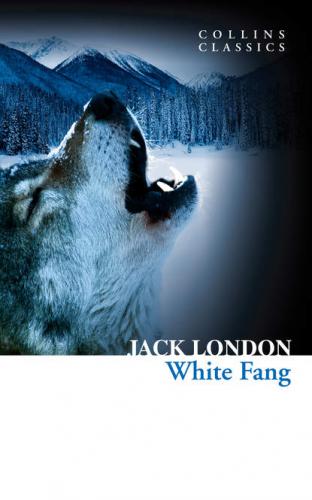The Call of the Wild has been adapted into various films and television series – it is a tale that translates so well to different media because it is both straightforward and emotive. The audience can easily tell who the good people are and who London intends for us to view as bad people, and the story is imbued throughout with pathos. After experiencing genuine kindness from John Thornton and then losing him, Buck returns to the wild and London’s message seems to be that love, warmth and contentment should be appreciated as it is often short-lived. He also shows that the struggle for survival is instinctual – as the story draws to an end, Buck has recovered his ancestral, primitive behaviour and fully detached himself from the civilized world that he knew.
White Fang
First serialized in an American magazine and then published in 1906, the novel White Fang focuses on the domestication of a wild beast, a plotline which reverses the theme of Jack London’s previous book, The Call of the Wild (1903). Set during the Klondike Gold Rush of the 1890s, one of the story’s strengths is the author’s ability to capture the brutal reality of survival in the wilds of the Yukon, Canada.
The eponymous main ‘character’ is part wolf, part dog, and he eventually finds himself living among humans where his lot is only marginally better than in the harsh wilderness. A sense of alienation surrounds White Fang, who is persecuted by wolves for being part dog and then by dogs for being part wolf. He becomes so toughened by the hostility of the world around him that he transforms into a vicious killer, an inevitable consequence of his instinct to survive.
Jack London anthropomorphized White Fang and the other animal characters – giving them human personality traits and voices – so that he could reflect on society and its failures without being overly moralistic, which would have been a natural consequence of using human, rather than animal, characters. Its social commentary aside, White Fang remains a well-loved tale, comprising many twists and turns, highs and lows, friends and foes.
Contents
Chapter 1: The Trail of the Meat
Chapter 1: The Battle of the Fangs
Chapter 4: The Wall of the World
Chapter 4: The Trail of the Gods
Chapter 1: The Enemy of His Kind
CLASSIC LITERATURE: WORDS AND PHRASES adapted from the Collins English Dictionary
Dark spruce forest frowned on either side the frozen waterway. The trees had been stripped by a recent wind of their white covering of frost, and they
